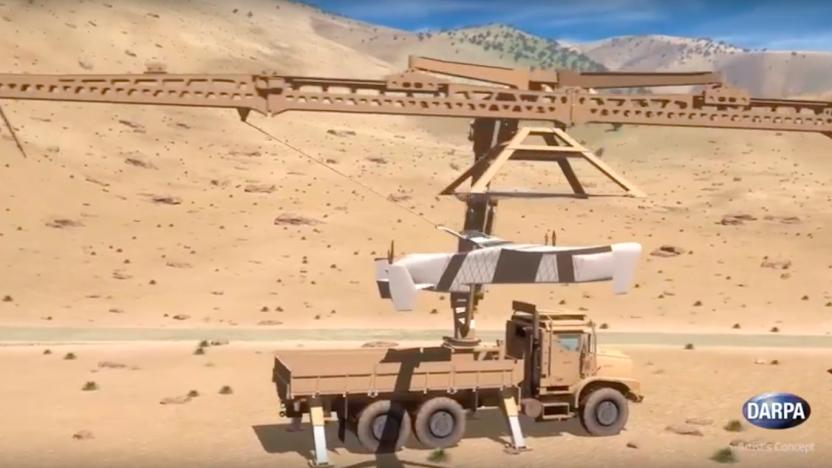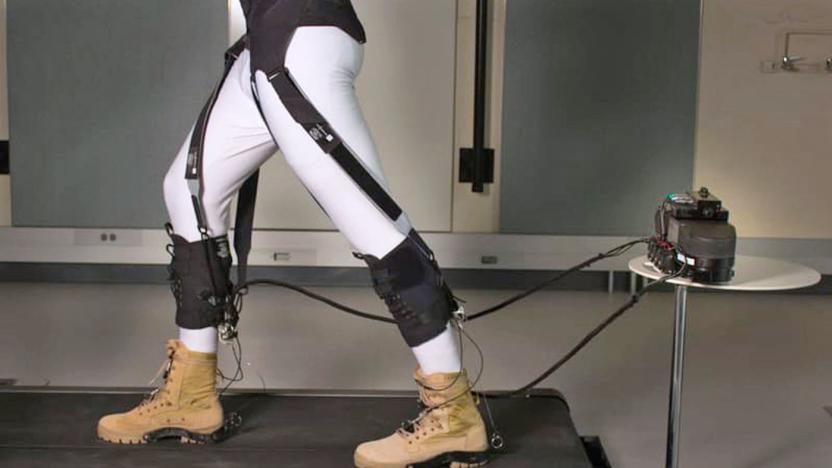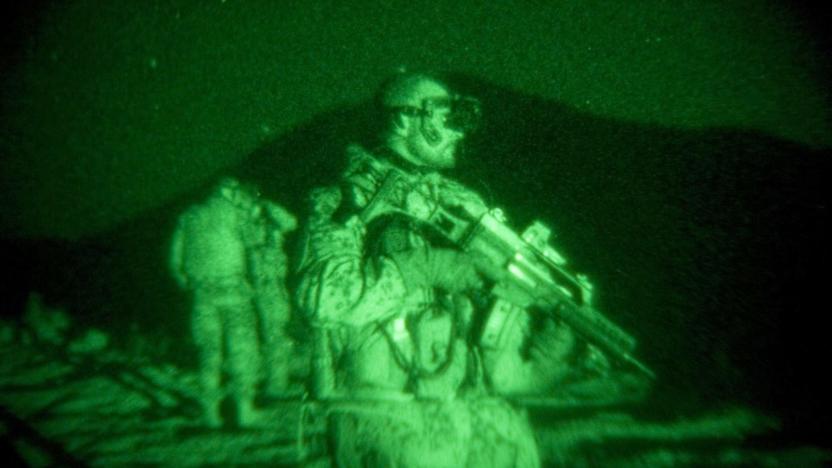Darpa
Latest

ICYMI: DARPA's drone snatcher and Pokémon: Minecraft edition
Today on In Case You Missed It: DARPA unveiled a UAV recovery systems that can catch a 1,000-pound drone but still fit comfortably in a standard 20-foot shipping container. The SideArm, as it's called, uses the same arresting-wire system that full-sized military jets use aboard aircraft carriers -- just, you know, upside down. We also take a look what happens when modders manage to stuff a full Pokémon game (in this case, "Cobalt and Amethyst") into the Minecraft universe. Modder Phoenix SC reportedly spent 31 months creating the add-on. It contains a brand-new storyline, 136 new Pokémon and about 70 hours of gameplay. Just make sure you catch this unofficial addition to the Pokémpire before Team Nintendo arrives. As always, please share any interesting tech or science videos you find by using the #ICYMI hashtag on Twitter for @engadget or @mskerryd.

DARPA's SideArm system snares drones from mid-air
Even the longest-loitering drone needs to land sometime. But rather than risk damaging these multi-million dollar aircraft on improvised battlefield landing strips or aboard US Naval vessels, DARPA is developing a novel drone recovery system that snatches them out of mid-air.

Harvard's soft exosuit makes walking 23 percent easier
Harvard Wyss Institute researchers have been working on a soft exosuit with DARPA's financial help for years. While they were able to present a proof of concept in 2016, it's only now that they've found out just how much the suit can actually help its wearer. According to a new study published in Science Robotics, Harvard's exosuit reduces the energy a user needs to exert while walking by 23 percent. It does that by providing assistive force to the ankle at the perfect moment when you take another step.

Smart bullets will help warships fend off drone swarms
Navies already have a lot to worry about between rival warships and aircraft, but it's only going to get worse when drone swarms of all kinds threaten to overwhelm their defenses. The US Navy might not have that problem, though: DARPA just tapped Raytheon for the second phase of a smart bullet development project that will help fight off swarming attacks. The MAD-FIRES project (Multi Azimuth Defense Fast Intercept Round Engagement System) should lead to ammo that's as fast and small as what you'd find in a medium-caliber gun (20- to 40-caliber), but with the guidance of a missile. if a horde of robotic flyers appeared, a vessel could theoretically take all of them out even if they're approaching from different directions.

DARPA tests buoy network for fallback military comms at sea
It doesn't matter how many war machines you have under your command if you can't relay orders to their operators. Maintaining communications is just as important as firepower, and DARPA wants the armed forces to have as many contingencies as possible when networks go down or are actively jammed. Setting up a fallback network is even trickier on the open ocean, but the agency's Tactical Undersea Network Architecture (TUNA) program is well on its way to a solution. That solution being a collection of "node" buoys, deployed from ships or planes, that are tethered together by fiber optic cables to create a radio frequency data network.

DARPA is giving war vets first access to LUKE bionic arms
DARPA's sophisticated LUKE bionic arm is ready for production, eight years after its development began and a couple of years after it was approved by the FDA. Before the bionic limb makes the transition into a commercial product, though, the military division is giving war veterans access to its initial production run. DARPA's Biological Technologies Office director Justin Sanchez has recently delivered two LUKE arms to the Walter Reed National Military Medical Center for use by a couple of vets in need of a prosthetic limb.

Transmitter tech opens the door to underwater radio
It's easy to take modern wireless communication for granted above ground, but it's useless in areas where the signals can't propagate, like underwater or in caves. DARPA might have a better way: its AMEBA (A Mechanically Based Antenna) team is developing portable ultra-low-frequency (1Hz to 3kHz) and very low frequency (3kHz to 30kHz) transmitters that could penetrate materials like water and stone with basic data. Scuba divers could send text messages to each other, for instance, while search and rescue teams could still contact the outside world while they're in tunnels.

DARPA wants your gaming tactics for its drone army
Urban areas continue to vex the US military as tall buildings and narrow streets keep impeding troop communications and tactics. While ground soldiers have used single drones for years, DARPA believes that a whole swarm could mitigate those disadvantages, giving units more eyes and guns. Since the military is currently unable to control such swarms, DARPA is launching a new program to develop both drone-wrangling tech and the tactics they'd need to assist soldiers in urban environments. Oh, and they want video gamers to playtest the best strategies.

Nanotechnology discovery could lead to low-power night vision
Night vision technology is essential on the modern battlefield but is not without its shortcomings. Conventional night vision goggles (NVGs) have been compared to looking "through toilet paper tubes" on account of their drastically diminished peripheral view. Even the top-of-the-line L-3 Ground Panoramic NGVs -- the ones used by US special forces during the Osama bin Laden raid -- are heavy, cumbersome and require an external power source. However, a breakthrough discovery out of the Australian National University could give us NGVs that are no thicker than a pair of normal sunglasses.

The Atlas robot is getting better at chasing you down
Boston Dynamics' upright-and-walking-on-two-legs Atlas robot is a slightly terrifying while simultaneously an amazing piece of technology. But during its initial demos the DARPA-funded automaton needed a clear and fairly even path to walk. Now thanks to researchers at the Florida Institute for Human & Machine Cognition (IMHC), Atlas is ready to go almost everywhere. Just very very slowly.

ICYMI: The balloon bot that can actually stand upright
try{document.getElementById("aol-cms-player-1").style.display="none";}catch(e){}Today on In Case You Missed It: A scientist at UCLA's Robotics & Mechanisms Laboratory is experimenting with a way to get around the fact that robots have a difficult time maintaining a high center of gravity, aka they always fall down; so he's built something that looks like a balloon on stick insect legs. It's still very much a prototype but perhaps the idea will remain in future walking bots. Meanwhile, scientists at SLAC came up with a way to spot photosynthesis at room temperature, using an X-ray laser. Previous tests had always relied on freezing leaves to track it. If you're getting your projects in order for the coming weekend, we recommend the DIY fire tornado. If you're looking for the Rubix Cube solving bot, that's here. As always, please share any interesting tech or science videos you find by using the #ICYMI hashtag on Twitter for @mskerryd.

ICYMI: Orbital space junk is putting us in jeopardy
try{document.getElementById("aol-cms-player-1").style.display="none";}catch(e){}Today on In Case You Missed It: The US Air Force is moving its Space Surveillance Telescope to Australia to track space junk littering geosynchronous orbit. That's the orbit 22,000 miles away from our planet where satellites mirror the Earth's rotation so that they don't appear to move. The Department of Justice story about facial recognition is here, while that darling sneezing baby (who eschews costumes) is here. If you enjoy the cartoon humor that is an engine giving up on a job, that's here. As always, please share any interesting tech or science videos you find by using the #ICYMI hashtag on Twitter for @mskerryd.

ICYMI: Bot is my co-pilot
try{document.getElementById("aol-cms-player-1").style.display="none";}catch(e){}Today on In Case You Missed It: DARPA's autopilot system for military planes is being tested, this time in a Cessna Caravan turboprop plane. It's made up of a robotic arm and tablet with speech recognition, so communicating with the mechanical brain is supposed to be even easier. Meanwhile, ping-pong fans will want to know about new paddles that set the music based on the pace of the rally. A new product designed for gamers with haptic actuators is here, while just for kicks, the Price is Right celebration is here. As always, please share any interesting tech or science videos you find by using the #ICYMI hashtag on Twitter for @mskerryd.

DARPA's telescope will keep the military's satellites safe
DARPA is officially done developing the Space Surveillance Telescope (SST) and has handed it over to the US Air Force. Pentagon's most adventurous arm worked with the military division for over a decade to build the SST, which was designed to monitor space junk that pose a threat to satellites in orbit. It's been observing asteroids and near-Earth objects since 2011 in New Mexico, but now that it has officially changed hands, the SST will go through some big changes. Perhaps the biggest of which is its home: the Air Force plans to uproot the whole structure and ship it off to Australia.

Watch DARPA's autopilot system fly a turboprop plane
It'll likely take a long time before DARPA's autopilot system flies military planes on its own, but this latest demonstration proves that it works. Aurora Flight Sciences, the aviation company that's developing the technology for the agency, has successfully tested it on a Cessna Caravan turboprop aircraft. Aircrew Labor In-Cockpit Automation System or ALIAS is comprised of a robotic arm and a tablet-based user interface with speech recognition, among other components. When installed on a plane, it acts as the co-pilot in charge of flying the aircraft -- its human companions can chill and spend their time keeping an eye on the weather or looking out for any potential threats.

ICYMI: The ESA's mission to Mars launches next week
try{document.getElementById("aol-cms-player-1").style.display="none";}catch(e){}Today on In Case You Missed It: The European Space Agency and Russia are joining up to launch their ExoMars project next week, which will look for traces of extraterrestrial life on the red planet. Meanwhile, a newer kind of wind energy harvester is being installed in Paris, where leaves on a fake tree can capture energy in breezy conditions.

DARPA wants an 'Aerial Dragnet' to monitor urban drone traffic
Conventional air traffic might be tightly controlled and monitored, but even with the new FAA regulations, drones and other unmanned aerial systems are mostly operating without any government oversight. And that doesn't sit well with the folks at the Pentagon, who fear that easy access to affordable drones could make them easily adaptable for terrorist or military purposes. To combat this potential threat, the Defense Advanced Research Projects Agency, announced this week an "Aerial Dragnet" program that aims to map all small drone activity in urban settings.

Hacking and AI: Moral panic vs. real problems
On Aug. 4th, seven different artificial intelligence systems competed against each other to see which was best at hacking. The Cyber Grand Challenge was sponsored by DARPA (the US Defense Advanced Research Projects Agency) and held at Def Con, in a vast ballroom remade to resemble an e-sports broadcast. Of course, because we're talking about about AIs made to seek out security vulnerabilities (and either patch or exploit them), some were inclined to scream "Skynet!" and run for the hills.

The robots of war: AI and the future of combat
The 1983 film WarGames portrayed a young hacker tapping into NORAD's artificial-intelligence-driven nuclear weapons' system. When the hit movie was screened for President Reagan, it prompted the commander in chief to ask if it were possible for the country's defense system network to be compromised. Turns out it could. What they didn't talk about was the science fiction of using AI to control the nation's nuclear arsenal. It was too far-fetched to even be considered. Until now.

AI hackers will make the world a safer place -- hopefully
The spotlights whirl in circles and transition from blue to purple to red and back to blue again. Basking in the glow is a stage constructed to resemble something out of a prime-time singing competition. But instead of showcasing would-be pop stars, the backdrop is built to push 21kW of power while simultaneously piping 3,500 gallons of water to cool its contestants. Those seven competitors were actually server boxes autonomously scanning and patching vulnerabilities.







